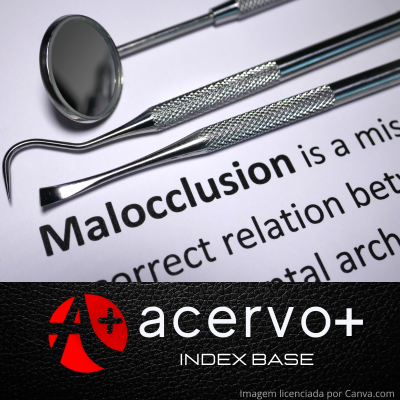Índices oclusais para avaliação das maloclusões
##plugins.themes.bootstrap3.article.main##
Resumo
Objetivo: Realizar uma revisão integrativa da literatura para identificar os índices oclusais propostos para avaliação das maloclusões. Métodos: Realizou-se uma revisão integrativa da literatura nas bases de dados BVS e PubMed). Utilizou-se os descritores index, orthodontics, malocclusion e occlusion combinados com o operador booleano AND. Resultados: Foram recuperados 1.309 estudos nas buscas realizadas nas bases de dados. Após análise dos títulos, resumos e língua dos estudos, 1.298 foram excluídos, considerando-se os critérios de inclusão. Posteriormente, 11 estudos foram elegíveis e lidos integralmente. Destes, somaram-se mais 4 estudos, devido à análise das referências dos estudos selecionados. Por fim, 15 estudos foram incluídos nesta revisão integrativa. Considerações finais: Foram identificados 15 índices oclusais para avaliação das maloclusões com diferentes objetivos e metodologias. Por fim, exalta-se que não há um único índice com aceitação e aplicação universal, mas sim aquele que melhor se aplica ao que o ortodontista deseja analisar.
##plugins.themes.bootstrap3.article.details##
Copyright © | Todos os direitos reservados.
A revista detém os direitos autorais exclusivos de publicação deste artigo nos termos da lei 9610/98.
Reprodução parcial
É livre o uso de partes do texto, figuras e questionário do artigo, sendo obrigatória a citação dos autores e revista.
Reprodução total
É expressamente proibida, devendo ser autorizada pela revista.
Referências
2. ALHAMMADI HA, et al. Index of complexity, outcome, and need (ICON) in Dubai school-aged adolescentes. APOS Trend Orthod, 2020; 10(1): 32-37.
3. BEDI R, et al. A study of satisfaction with dental services among adults in the United Kingdom. Br Dent J, 2005; 198(7): 433-437.
4. BROOK PH e SHAW WC. The development of an index of orthodontic treatment priority, Eur J Orthod, 1989; 11(3): 309-320.
5. BURDEN DJ, et al. Modified IOTN: an orthodontic treatment need index for use in oral health surveys. Community Dent Oral Epidemiol, 2001; 29(3): 220-225.
6. CASKO JS, et al. Objective grading system for dental casts and panoramic radiographs. American Board Orthodontics. Am J Orthod Dentofacial Orthop, 1998; 114(5): 589-599.
7. DANIELS C e RICHMOND S. The development of the index of complexity, outcome and need (ICON). J Orthod, 2000; 27(2): 149-162.
8. DRAKER HL. Handicapping labio-lingual deviations: A proposed index for public health purposes. Am J Orthod, 1960; 46(4): 295-305.
9. EXAME DA FASE II - CRITÉRIOS DE AVALIAÇÃO. Board Brasileiro de Ortodontia e Ortopedia Facial. Disponível em: https://bbo.org.br/exame-da-fase2/criterios-de-avaliacao. Acessado em: 2 de julho de 2023.
10. GEORGE AM, et al. Formulating a new orthodontic index: An indian board of orthodontics initiative. J In Orthod Soc, 2020; 54(2): 147-149.
11. GRAINGER RM. Orthodontic treatment priority index. Vital Health Statistic, 1967; 2(25): 1-49.
12. GRABER TM. Ortodoncia teoria y prática. Nueva Editorial Interamericana, 1977.
13. GRAY AS e DEMILJIAN A. lndexing occlusions for dental public health programs. Am J Orthod, 1977; 72(2): 191-197.
14. HONG M, et al. The Improvement and Completion of Outcome index: A new assessment system for quality of orthodontic treatment. Korean J Orthod, 2016; 46(4): 199-211.
15. HOWITT JW, et al. Eastman Esthetic lndex. NY State Dent J, 1967; 33: 215-220.
16. IRELAND R. Oxford Dictionary of Dentistry. Oxford University Press, 2010.
17. KHANDAKJI MN e GHAFARI JG. Evaluation of commonly used occlusal indices in determining orthodontic treatment need. Eur J Orthod, 2020; 42(1): 107-114.
18. LIEBER WS, et al. Clinical use of the ABO-Scoring Index: Reliability and subtraction frequency. Angle Orthod, 2003; 73(5): 556-564.
19. LITTLE, R. The irregularity index. Am J Orthod Dentofacial Orthop, 1975; 68(5): 554-563.
20. LLEWELLYN SK, et al. An index of orthodontic treatment complexity. Eur J Orthod, 2007; 29(2): 186-192.
21. NAITO M, et al. Oral health status and health-related quality of life: a systematic review. J Oral Sci, 2006; 48(1): 1-7.
22. PINTO EM, et al. Análise crítica dos diversos métodos de avaliação e registro das más oclusões. Dent Press Ortodon Ortop Facial, 2008; 13(1): 82-91.
23. PITHON MM, et al. Os modelos ortodônticos digitais são confiáveis? Uma revisão sistemática. HU Revista, 2018; 44(1): 97-113.
24. PROFFIT WR, et al. Contemporary orthodontics. Elsevier/Mosby, 2013; 10-11p.
25. RICHMOND S, et al. The development of the PAR Index (Peer Assessment Rating): reliability and validity. Eur J Orthod, 1992; 14(2): 125-139.
26. RUSSELL AL. A system of classification and scoring for prevalence surveys of periodontal disease. J Dent Research, 1956; 35: 350-359.
27. SALZMANN JA. Handicapping malocclusion assessment to establish treatment priority. Am J Orthod, 1968; 54(10): 749-765.
28. SHAW WC, et al. The use of occlusal indices: a European perspective. Am J Orthod Dentofacial Orthop, 1995; 107(1): 1-10.
29. SOH CL e NARAYANAN V. Quality of life assessment in patients with dentofacial deformity undergoing orthognathic surgery - A systematic review. Int J Oral Maxillofac Surg, 2013; 42(8): 974-980.
30. SUMMERS CJ. The occlusal index: A System for identifying and sconng oclusal disorders. Am J Orthod, 1971; 59(6): 552-566.
31. VAN KIRK LJ e PENNELL EH. Assessment of malocclusion in population groups. Am J Orthod Dental Orthop, 1959; 45(10): 752-758.
32. WORLD HEALTH ORGANIZATION. An international methodology for epidemiological study of oral disease. 1rd ed. Geneva, 1966.
33. WORLD HEATH ORGANIZATION. Oral health surveys: basic methods. 4rd ed. Geneva, 1997.

